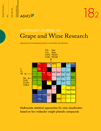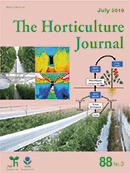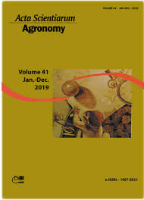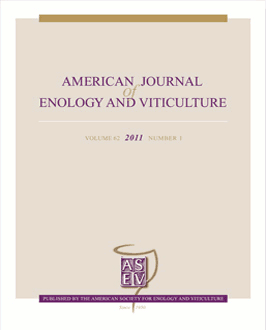
VITIS
Scope & Guideline
Fostering Excellence in Viticultural Research
Introduction
Aims and Scopes
- Genetic and Genomic Studies:
Research exploring grapevine genetics, molecular characterization, and breeding strategies to improve disease resistance and enhance grape quality. - Ecophysiology and Environmental Interactions:
Studies investigating the physiological responses of grapevines to environmental stresses, such as water deficit, salinity, and temperature variations. - Viticultural Practices and Innovations:
Research focused on viticultural techniques, including soil management, irrigation practices, and the use of technology for precision viticulture. - Diversity and Conservation of Grape Varieties:
Investigations into the genetic diversity of grapevine varieties, conservation efforts, and the exploration of traditional and heritage cultivars. - Pathology and Pest Management:
Research addressing grapevine diseases, pest interactions, and the development of sustainable management practices to mitigate their impact. - Wine Quality and Sensory Analysis:
Studies assessing the chemical composition of grapes and wines, their sensory characteristics, and the influence of viticultural practices on wine quality.
Trending and Emerging
- Biotechnological Applications in Viticulture:
An increasing focus on biotechnological approaches, such as RNA interference and genetic modification, to enhance grapevine resistance to diseases and pests. - Climate Change Adaptation Strategies:
Research addressing the impacts of climate change on grapevine cultivation, including studies on abiotic stress tolerance and the adaptation of grape varieties to changing climates. - Precision Agriculture and Technological Innovations:
Growing interest in the application of technology in viticulture, including the use of sensors, data analytics, and modeling for improved grapevine management. - Sustainable Practices and Organic Viticulture:
A trend towards sustainability in viticulture, with research exploring organic practices, soil health, and environmentally friendly pest management strategies. - Functional Foods and Health Benefits of Grapes:
Emerging studies investigating the health benefits of grape compounds, expanding the scope of research beyond traditional winemaking to include functional food applications.
Declining or Waning
- Traditional Winemaking Techniques:
Research exploring traditional methods of winemaking has decreased, possibly as a result of increased interest in modern techniques and innovations that enhance efficiency and quality. - General Agronomy Studies:
Broader studies on agronomy not specifically related to grapevines have been less prominent, indicating a more specialized focus on viticulture-specific research. - Non-scientific or Anecdotal Reports:
The prevalence of non-scientific articles or anecdotal findings has waned, suggesting a move towards more rigorous, data-driven research methodologies.
Similar Journals

Legume Research
Unlocking the Potential of Legumes for Global ImpactLegume Research, published by the AGRICULTURAL RESEARCH COMMUNICATION CENTRE in India, is an essential peer-reviewed journal focusing on advancements in the field of agronomy, crop science, soil science, and plant science. With an ISSN of 0250-5371 and operating since 2008, this journal caters to researchers, agricultural professionals, and students interested in the critical role of legumes in sustainable agriculture and food security. It ranks within the third quartile (Q3) in several prominent categories, reflecting its contribution to the agricultural and biological sciences community—ranking #279 in Agronomy and Crop Science, #113 in Soil Science, and #376 in Plant Science based on Scopus metrics. Although not open access, Legume Research remains a vital resource for those seeking to enhance their knowledge and contribute novel research findings in the ever-evolving discipline of legume cultivation and utilization. With a clear objective to disseminate impactful research, this journal significantly contributes to the global understanding of legumes' ecological, economic, and nutritional importance.

AUSTRALIAN JOURNAL OF GRAPE AND WINE RESEARCH
Innovating Knowledge for the Future of Wine ScienceAustralian Journal of Grape and Wine Research, published by Wiley, is a premier academic journal dedicated to advancing knowledge in the field of viticulture and enology. With an impressive impact factor reflecting its significance, the journal is ranked in the Q1 quartile for Horticulture, placing it among the top-tier journals in its category, and enjoys a commendable ranking of #15/115 in Scopus for Agricultural and Biological Sciences. The journal has been serving the scientific community since its inception in 1995 and continues to be a vital resource for researchers, professionals, and students engaged in grape and wine research. Accessible through subscription, it provides a platform for publishing innovative research findings and insightful reviews that foster discourse in viticulture, wine quality, and sustainability practices. For anyone passionate about the science of grapevine cultivation and wine production, the Australian Journal of Grape and Wine Research is an indispensable source of knowledge and inspiration.

AMERICAN JOURNAL OF POTATO RESEARCH
Fostering Global Research in Potato AgricultureAMERICAN JOURNAL OF POTATO RESEARCH is a prominent scholarly journal dedicated to the field of potato research, encompassing vital areas of Agronomy and Crop Science. Published by SPRINGER, this journal holds an impactful presence in the scientific community, as evidenced by its placement in the Q2 quartile of both Agronomy and Plant Science categories for 2023. With a Scopus rank of #145 out of 406 in Agricultural and Biological Sciences, it offers a significant platform for researchers, professionals, and students alike. Covering diverse topics from cultivation techniques to pest management, the journal aims to advance understanding and innovation in potato science, facilitating the sharing of cutting-edge research and fostering collaboration among scholars. Accessible to a global audience, the journal encourages the dissemination of knowledge through its open-access options. Since its inception in 1998, the AMERICAN JOURNAL OF POTATO RESEARCH has been committed to contributing valuable insights that drive the industry forward and support sustainable agricultural practices.

Horticulture Journal
Transforming Horticultural Research into PracticeThe Horticulture Journal, published by the Japan Society for Horticultural Science, is a leading academic platform dedicated to the advancement of horticultural research and practices. With an ISSN of 2189-0102 and an E-ISSN of 2189-0110, this journal endeavors to publish high-quality research that emphasizes innovative techniques, sustainable practices, and the science of plant cultivation. The journal has been recognized for its impact within the field, currently holding a Q2 ranking in Horticulture and a Q3 ranking in Plant Science as of 2023, indicating its significant contribution to advancing knowledge. With its open-access model, researchers, professionals, and students have the opportunity to engage with the latest findings, thanks to the journal's commitment to widespread dissemination of information. Since its convergence period began in 2015 and continuing through to 2024, the Horticulture Journal remains instrumental in promoting sustainable and beneficial practices in horticulture science globally.

Egyptian Journal of Agronomy
Exploring the Frontiers of Agricultural ExcellenceEgyptian Journal of Agronomy, published by the NATL INFORMATION DOCUMENTATION CENT, ACAD SCIENTIFIC RESEARCH & TECHNOLOGY, serves as a pivotal platform for researchers, professionals, and students focusing on various disciplines within the agricultural sciences, including agronomy, soil science, horticulture, and ecology. With an ISSN of 0379-3575 and E-ISSN of 2357-0288, the journal aims to bridge the gap in knowledge and innovation in the field with its comprehensive studies and frameworks. While the journal is currently categorized in low Scopus ranks, indicating immense potential for growth in influence and impact, it remains dedicated to providing quality research and fostering advancements in agronomic practices. Set in Egypt, a hub for agricultural research, the journal is committed to reflecting the regional and global challenges in agriculture. The Egyptian Journal of Agronomy is a vital resource for anyone engaged in the evolving landscape of agricultural science, offering insights that promote sustainable practices and address current issues facing the sector.

CROP SCIENCE
Transforming agronomy with impactful research and findings.CROP SCIENCE, published by WILEY, is a premier journal dedicated to the field of agronomy and crop science, offering a platform for high-quality research on crop production, genetics, and sustainable agricultural practices. With an impactful presence since its inception in 1974, the journal has become a significant contributor to advancing knowledge in this critical field, as evidenced by its Q2 ranking in the 2023 categorizations and a Scopus rank in the 72nd percentile among its peers. The journal's aim is to disseminate innovative research findings that inform best practices and policies for enhancing crop yield and sustainability, making it an essential resource for researchers, professionals, and students alike. Although CROP SCIENCE does not currently offer open access options, the journal’s extensive readership and reputation make it a valuable asset for anyone invested in the future of agriculture.

ACTA SCIENTIARUM-AGRONOMY
Connecting researchers to the pulse of agricultural innovation.ACTA SCIENTIARUM-AGRONOMY is a prestigious, peer-reviewed journal published by UNIV ESTADUAL MARINGA, PRO-REITORIA PESQUISA POS-GRADUACAO, focusing on advanced research in the field of agronomy and crop science. Since its inception as an Open Access journal in 2007, it has significantly contributed to disseminating high-quality research, allowing unrestricted access to its content for a global audience. Operating from Brazil, the journal holds a notable Q2 category ranking in Agronomy and Crop Science as of 2023, validating its importance within the academic community. The journal’s Scopus ranking positions it in the 49th percentile among Agricultural and Biological Sciences, indicating a robust foundation for impactful research. With a commitment to innovation and scientific excellence, ACTA SCIENTIARUM-AGRONOMY aims to provide researchers, professionals, and students with vital insights that drive forward our understanding of agriculture and its environmental implications.

Revista Caatinga
Connecting Local Practices to Global SolutionsRevista Caatinga is a premier open-access journal published by Universidade Federal Rural do Semi-Árido (UFERSA), dedicated to the dissemination of significant research within the field of Agricultural and Biological Sciences. Since its inception in 2006, the journal has aimed to bridge the knowledge gap in various aspects of agricultural practices and biological phenomena, making vital contributions to the scientific community. With its publications indexed in Scopus and holding an impressive Q2 categorization in the competitive landscape of agricultural sciences, the journal ranks within the top half of its category (100/221), demonstrating a commitment to quality scholarship. The journal is based in Brazil and covers a wide array of topics relevant to both local and global agricultural challenges. By fostering open access, Revista Caatinga ensures that vital research is available to a broad audience, promoting knowledge sharing and collaboration among researchers, practitioners, and students around the world.

Agricultural Science and Practice
Connecting researchers to enhance agricultural methodologies.Agricultural Science and Practice is a pivotal journal dedicated to advancing knowledge and research in the field of agricultural sciences. Published by the NATIONAL ACADEMY OF AGRARIAN SCIENCES OF UKRAINE, this journal serves as a vital resource for researchers, professionals, and students engaged in agriculture, agronomy, and related disciplines. The journal aims to disseminate high-quality, peer-reviewed articles that address contemporary issues, innovative practices, and advancements in agricultural methodologies. While currently specified as non-open access, the journal endeavors to contribute significantly to the global agricultural knowledge pool while fostering a collaborative research environment. With its base in Kyiv, Ukraine, Agricultural Science and Practice plays an essential role in highlighting regional agricultural challenges and solutions, thereby attracting a diverse readership that aspires to enhance food security and sustainable farming practices worldwide.

AMERICAN JOURNAL OF ENOLOGY AND VITICULTURE
Advancing the Science of Wine and Vine.The American Journal of Enology and Viticulture, published by the American Society of Enology and Viticulture, serves as a pivotal platform for scholarly research in the disciplines of enology and viticulture. With a distinguished ISSN of 0002-9254 and an E-ISSN of 1943-7749, this esteemed journal has been contributing significant insights since its inception in 1973. Currently residing in the prestigious Q2 category for both Food Science and Horticulture, it ranks impressively among its peers, standing at #27 out of 115 in the Horticulture sector and #165 out of 389 in Food Science, reflecting its impact and relevance in agricultural research. The journal offers a wealth of valuable research articles, reviews, and studies that explore the intricacies of grape cultivation and wine production, making it an indispensable resource for researchers, professionals, and students keen on advancing their knowledge in these fields. Although it does not currently operate under an open-access model, the rigorous peer-review process ensures that only high-quality, scientifically sound content is disseminated, promoting innovation and collaboration in the pursuit of excellence in viticulture and enology.